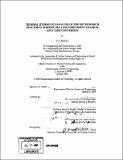| dc.contributor.advisor | Lin-wen Hu and Mujid S. Kazimi. | en_US |
| dc.contributor.author | Ko, Yu-Chih, Ph. D. Massachusetts Institute of Technology | en_US |
| dc.contributor.other | Massachusetts Institute of Technology. Dept. of Nuclear Science and Engineering. | en_US |
| dc.date.accessioned | 2009-03-16T19:40:56Z | |
| dc.date.available | 2009-03-16T19:40:56Z | |
| dc.date.copyright | 2008 | en_US |
| dc.date.issued | 2008 | en_US |
| dc.identifier.uri | http://hdl.handle.net/1721.1/44771 | |
| dc.description | Thesis (S.M.)--Massachusetts Institute of Technology, Dept. of Nuclear Science and Engineering, 2008. | en_US |
| dc.description | Includes bibliographical references (leaves 119-121). | en_US |
| dc.description.abstract | The MIT research reactor (MITR) is converting from the existing high enrichment uranium (HEU) core to a low enrichment uranium (LEU) core using a high-density monolithic UMo fuel. The design of an optimum LEU core for the MIT reactor is evolving. The objectives of this study are to benchmark the in-house computer code for the MITR, and to perform the thermal hydraulic analyses in support of the LEU design studies. The in-house multi-channel thermal-hydraulics code, MULCH-II, was developed specifically for the MITR. This code was validated against PLTEMP for steady-state analysis, and RELAP5 and temperature measurements for the loss of primary flow transient. Various fuel configurations are evaluated as part of the LEU core design optimization study. The criteria adopted for the LEU thermal hydraulics analysis for this study are the limiting safety system settings (LSSS), to prevent onset of nucleate boiling during steady-state operation, and to avoid a clad temperature excursion during the loss of flow transient. The benchmark analysis results showed that the MULCH-II code is in good agreement with other computer codes and experimental data, and hence it is used as the main tool for this study. In ranking the LEU core design options, the primary parameter is a low power peaking factor in order to increase the LSSS power and to decrease the maximum clad temperature during the transient. The LEU fuel designs with 15 to 18 plates per element, fuel thickness of 20 mils, and a hot channel factor less than 1.76 are shown to comply with these thermal-hydraulic criteria. The steady-state power can potentially be higher than 6 MW, as requested in the power upgrade submission to the Nuclear Regulatory Commission. | en_US |
| dc.description.statementofresponsibility | by Yu-Chih Ko. | en_US |
| dc.format.extent | 145 leaves | en_US |
| dc.language.iso | eng | en_US |
| dc.publisher | Massachusetts Institute of Technology | en_US |
| dc.rights | M.I.T. theses are protected by
copyright. They may be viewed from this source for any purpose, but
reproduction or distribution in any format is prohibited without written
permission. See provided URL for inquiries about permission. | en_US |
| dc.rights.uri | http://dspace.mit.edu/handle/1721.1/7582 | en_US |
| dc.subject | Nuclear Science and Engineering. | en_US |
| dc.title | Thermal hydraulics analysis of the MIT research reactor in support of a low enrichment uranium (LEU) core conversion | en_US |
| dc.type | Thesis | en_US |
| dc.description.degree | S.M. | en_US |
| dc.contributor.department | Massachusetts Institute of Technology. Department of Nuclear Science and Engineering | |
| dc.identifier.oclc | 300287555 | en_US |
